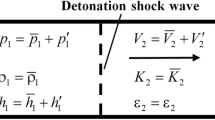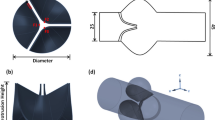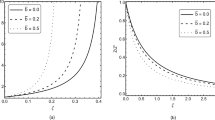Abstract
The wave structure in active bubble media in shock tubes with sudden changes of profiles in the form of “discontinuities” in cross section and a one‐phase liquid waveguide is analyzed numerically. In axisymmetric formulation, the paper studies wave amplification due to reflection from a wall and focusing at the butt‐end of a rigid rod aligned coaxially with the channel. In this configuration, the amplification effect results from two‐dimensional cumulation of the shock wave after it leaves the annular channel and reaches the butt‐end of the rod. A Mach configuration forms in the focus spot. The geometrical characteristics of the shock tube allow one to control (to some extent) the amplification coefficient and the coordinates of the focus spot. In particular, it is shown that the wave can be focused near the second discontinuity of cross section — a rigid wall (in the region of passage through the interface to the waveguide) — and intensified upon reflection. If the waveguide radius is equal to the height of the Mach stem, the reflected wave has a maximum amplitude.
Similar content being viewed by others
REFERENCES
V. K. Kedrinskii, “Propagation of perturbations in a liquid containing gas bubbles," J. Appl. Mech. Tech. Phys., 9, No. 4, 370-376 (1968).
V. E. Nakoryakov, E. S. Vasserman, B. G. Pokusaev, and N. A. Pribaturin, “Amplification of the amplitude of pressure waves in a vapor-liquid medium with a bubbly structure," Teplofz. Vys. Temp., 32, No. 3, 411-417 (1994).
V. E. Dontsov and V. E. Nakoryakov, “Propagation of shock waves in a porous medium saturated by a liquid with bubbles of a soluble gas," J. Appl. Mech. Tech. Phys., 41, No. 5, 845-854 (2000).
V. K. Kedrinskii, V. A. Vshivkov, G. I. Dudnikova, and Yu. I. Shokin, “Amplification of shock waves upon collision and focusing in bubble media," Dokl. Ross. Akad. Nauk, 361, No. 1, 41-44 (1998).
V. K. Kedrinskii, Yu. I. Shokin, V. A. Vshivkov, et al., “Generation of shock waves in a liquid by spherical bubble clusters," Dokl. Ross. Akad. Nauk, 81, No. 6, 773-776 (2001).
V. K. Kedrinskii, “The Iordansky-Kogarko-van Wijngaarden model: Shock wave and rarefaction wave interactions in bubbly media," Appl. Sci. Res., 58, Nos. 1/4, 115-130 (1997/1998).
V. K. Kedrinskii, P. A. Fomin, S. P. Taratuta, and A. A. Vasiliev, “Phase transition role in bubbly detonation problems," in: Proc. 22nd Int. Symp. on Shock Waves (London, July 18-23, 1999), Imperial College, London (1999), pp. 223-228.
V. K. Kedrinskii and F. N. Zamaraev, “Wave amplification in chemically active bubbly media," in: Proc. 17 th Int. Symp. on Shock Tube and Shock Waves (Bethlehem, July 17-21, 1989), Lehigh Univ., Bethlehem (1989), pp. 51-62.
O. M. Belotserkovskii and Yu. M. Davydov, The Particle-in-Cell Method in Gas Dynamics [in Russian], Nauka, Moscow (1982).
S. P. Taratuta, I. V. Maslov, and A. S. Besov, “Two-dimensional simulation of cavitation flows in channels of arbitrary shapes,” in: Dynamics of Continuous Media (collected scientific papers) [in Russian], No. 117, Novosibirsk (2001), pp. 146-150.
Author information
Authors and Affiliations
Rights and permissions
About this article
Cite this article
Kedrinskii, V.K., Maslov, I.V. & Taratuta, S.P. Wave‐field structure in active bubble systems in shock tubes with “discontinuities” in cross section. Journal of Applied Mechanics and Technical Physics 43, 256–263 (2002). https://doi.org/10.1023/A:1014753626144
Issue Date:
DOI: https://doi.org/10.1023/A:1014753626144




